How to make a mezzanine with your own hands?

Hallways in Soviet-built apartments rarely boast a large footage. And the number of cabinets in this cramped area was small - you can't really fit it. Because they helped out mezzanine, inconspicuous structures, the capacity of which is not overestimated even today. It is gratifying that mezzanines are relatively easy to make on your own.
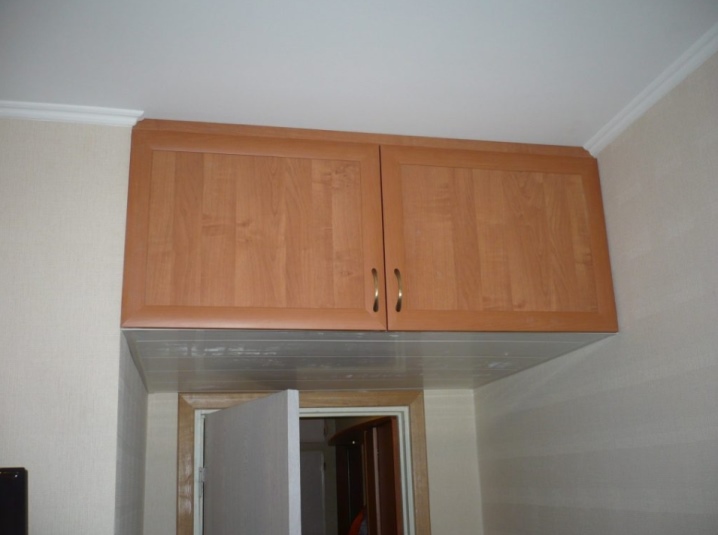
Choice of materials
Mezzanine - a convenient, compact-looking, utilitarian box. And it is made from different materials. Usually, MDF and chipboard are used due to the availability and cheapness of these materials. If possible, an array of wood is also used, which, in terms of quality, outperforms the two above options. Drywall is also used, but mostly for exterior decoration. The lining of the mezzanine box is often made from the lining.

Consider the materials that are most often used to make a mezzanine box.
- Chipboard... A good choice of material in terms of size and thickness, affordable cost, a sufficient selection of shades of laminated chipboard. This means that the material is not so difficult to choose to match the furniture in the hallway. Of the minuses - the resins in the chipboard, which at first may not emit the most pleasant smell. It is worth remembering that the material is afraid of moisture and when it is cut on its own, the risk of chips increases.
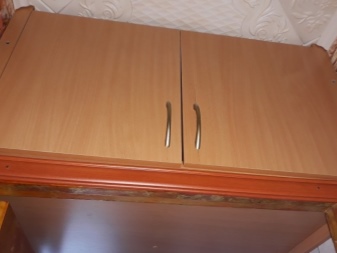

- MDF... It is used inside and outside the box, in terms of colors and dimensions, the choice is great, it is resistant to moisture. Resins are not used at the time of manufacture of MDF. There will be no unpleasant smell. The material will be highly durable, it is resistant to mechanical damage. You can count on a long service life. But the price of such a product is higher than that of chipboard, it is heavier, the sawing will have to be ordered in production, because it is difficult to cope independently, without special equipment.
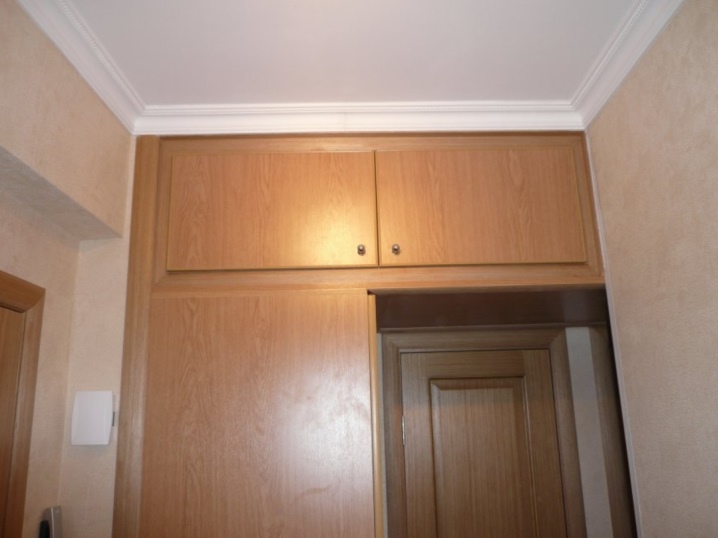
- Array... This is an eco-material, natural, easy to cut and process. You can count on his many years of service. But it is expensive, it does not tolerate high humidity in the best way. Too dry air will cause cracks. With temperature jumps, it can deform.
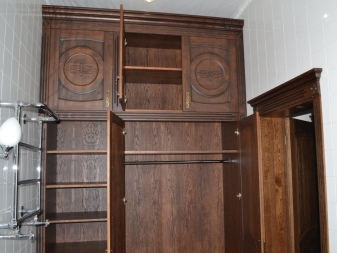

- Drywall... It is relatively cheap, tolerant to moisture and thermal shock, easy to manipulate and install. Lightweight material, but fragile, you need to work with it carefully. Not suitable for the base, it is used exclusively for external decoration. You will also need to make lags, which will become the support and base of the ceiling box.
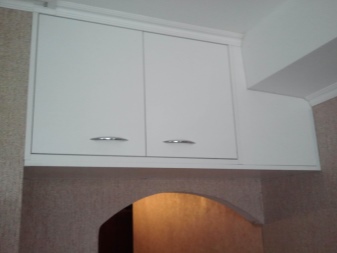
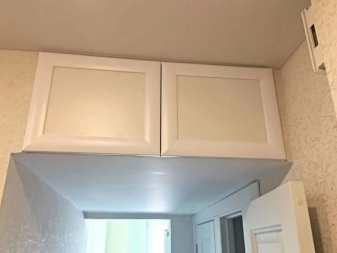
When choosing a material, you need to immediately think about what the outer finish of the box will be. It should be in harmony with the interior of the room.
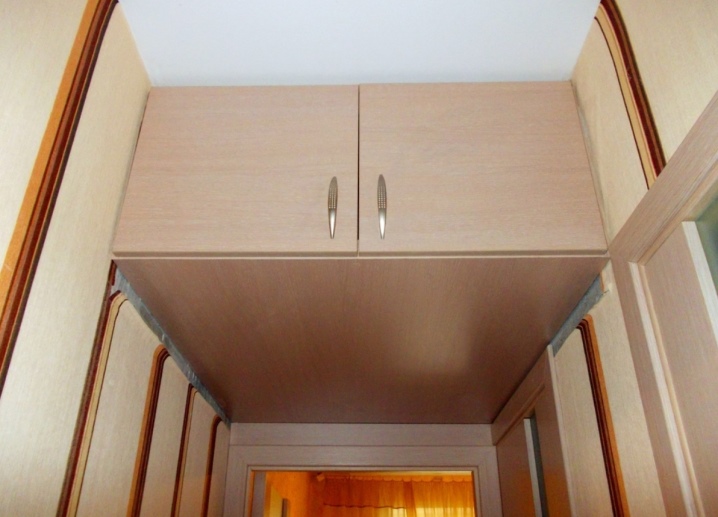
Tools and accessories
Initially, the design needs to be thought out, its dimensions, the amount of material required. The best solution would be to make a drawing of the box. We need to make sure that the walls that will hold the box are really strong and can handle the new load.
The following tools will come in handy at work:
- level;
- roulette;
- a screwdriver, or better - a screwdriver;
- puncher;
- jigsaw;
- aluminum profile;
- wooden beam;
- dowels, screws;
- pencil;
- the necessary accessories, hinges or guides;
- perhaps a click-and-gag mezzanine bracket will be used.
To this list should be added those items and tools that will help decorate the mezzanine.
Manufacturing technology
First you have to determine the placewhere electrical wiring runs in the hallway (or at another point in the apartment).If this moment is missed, the cable can be touched during the installation process, which will result in unpleasant consequences. An indicator screwdriver or a special finder that is sold in any large building market will help you find the wiring.
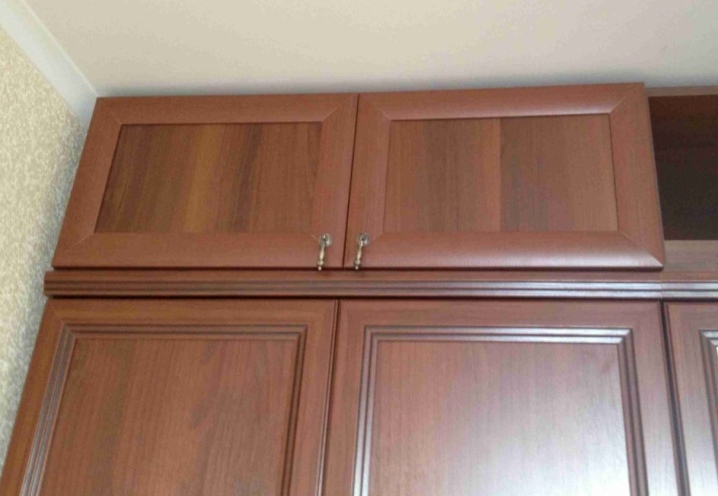
Marking and fastening the support
- Using a tape measure and a building level, you need to draw a line on the wall in the corridor, which will become a reference point. The base fasteners for the mezzanine stop will be mounted along it.
- Either a wooden beam or a metal corner can be used as an attachment. It is necessary to drill a hole in the fastener for a self-tapping screw, using a step of 15-20 cm. The part is applied to the line displayed on the wall, marked through the created holes in the fixation areas in the wall.
- Now you need to pick up a drill and make holes in the wall, put dowels with self-tapping screws there, fix the guides to the wall. The same actions are performed according to symmetry on the parallel wall, as well as above the door itself.
- If it is decided to make the box so that it will be sheathed with plasterboard, lags are made from the aluminum profile to the walls. And then the finished frame can be immediately fixed, sheathed with gypsum boards or any other identical material, plywood or fiberboard, and sometimes even plastic panels.
- When the support is made, the structure looks more and more like a small box or cabinet. Actually, it will be a small built-in wardrobe under the ceiling. These are done not only in hallways and corridors, but also, for example, in the toilet.
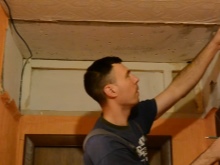
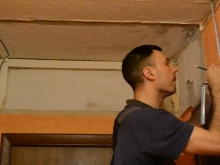
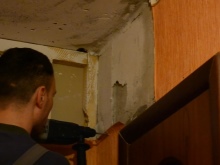
Base installation
From the sheet of the material from which it was decided to make the base, it follows with a jigsaw cut out the bottom of the future mezzanine... If chipboard is such a material, you can find an already made slab of the required size in the building market. Moreover, you can choose the pattern that is trimmed with an edge, which eliminates the need to decorate this edge. If it is decided to file the slab, then you will have to purchase an edge tape.
The bottom is installed in the designated place, fixed on wooden slats or corners with self-tapping screws. If the edge of the product is sawn off (that is, there is no edge), the bottom, fixed to the guides, must be moved forward by a couple of millimeters. This will make it easier to decorate the edge. And the edge tape is glued with glue, forming a neat end. This point of creating a mezzanine in step-by-step instructions is one of the simplest.

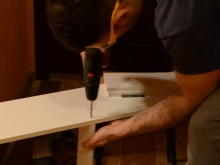
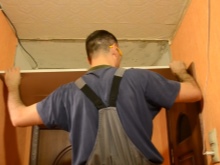
Assembling the door frame
Now make side racks and the top of the box... There will soon be placed the doors.
- Mark the desired height from the guides below to the place that will be the top of the mezzanine (or immediately to the ceiling).
- Just as happened with the lower rails, fix the side posts to the walls. Only wooden beams are used as a material.
- The upper bar will complete the installation of the box. It is attached to the side posts with corners.
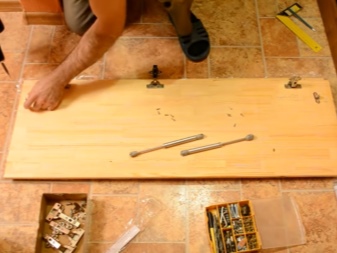
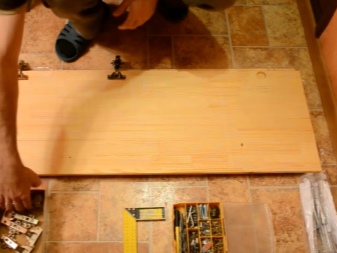
Hanging door leaves
When both the box and the base are ready at the mezzanine, its installation is nearing completion, need to be determined with the doors. And here several prospects open up. Doors can be made swing, sliding, with lifting mechanisms... You can do, depending on this, for example, mezzanine compartment, which is relevant today. Especially if there is a wardrobe of the same type in the hallway.
The canvas, which will become the door, can be found in the furniture industry. You can buy it in the building market, and the choice in this sense is great today. But if none of the standard blanks fit, there are still options.
- A chipboard sheet can be cut according to its own dimensions, after pasting over its ends with an edge band.
- If the tape is laminated, it will be connected to the plate using an ordinary iron. This is easy to do, as there is hot melt glue on the wrong side of the edge band.
- When the doors are ready, you need to find out which hinges to hang them on, because the choice of door hinges is huge. Card cards are a comfortable option for novice craftsmen, they can be hung without any problems.
- There is no need to make cuts, which have to be provided for in the case of overhead loops. It is very easy to attach the facade to card hinges: this is done using self-tapping screws and a screwdriver.
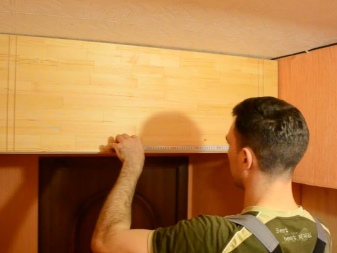
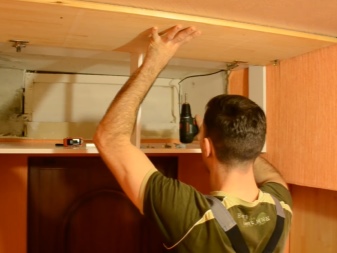
If it is a door that opens upwards, then it is better not to come up with mezzanine hinges... They are also fixed with self-tapping screws, but they have a spring inside the structure that keeps the door in the open position. And there is also a hinged door option that comfortably opens the sash up. A gas lift is immediately installed, that is, a system that will allow the doors to be easily opened / closed. And in the open position, they will be securely fixed.
It is also worth considering a sliding structure, but it would be wrong to call it the most convenient option. Access to what lies in the mezzanine will be limited to one of the doors. To install such a mechanism, you need to fix special rails / rollers. A double-sided mezzanine is mounted in the same way, except that the opening above the door to the kitchen will not be filled with bricks or a false panel (if repair requires it). When the superstructure is mounted in the corridor, then on the side of the kitchen, the hinged doors will make the long mezzanine two-sided.
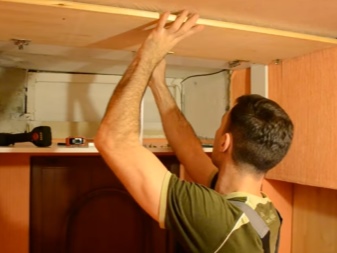
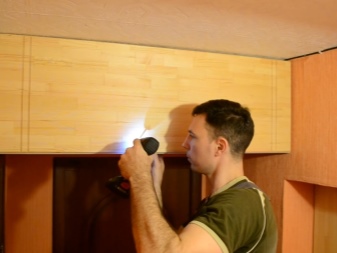
It makes sense to note such an option as curtains.
Until recently, it seemed primitive and did not fit every interior. Today, when many apartments take on the features of eco-style, as well as eco-boho, curtains instead of doors will look organic in such an interior... They are easy to maintain and can be changed seasonally or in the context of the holidays.


Decorating Tips
There are also a lot of options on how to decorate the doors beautifully. For example, you can cover with faux leather... Then such a mezzanine will organically look together with the front door or furniture design in the hallway. You can even try and create the effect of a carriage coupler, using the stapler from the outside. Paper clips in that case decorate with buttons, which are pre-covered with leatherette. In some variations, plastic rhinestones are used instead of buttons.
Another cool idea is glue a mirror sheet on the doors. It is very convenient to do this with self-adhesive mirror tiles. What is good about it is that the space of the corridor will visually appear both larger and higher.
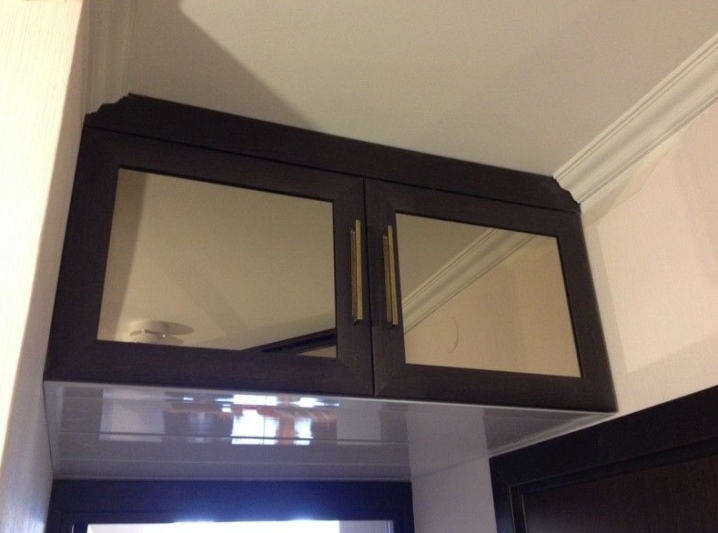
Other common and inexpensive options include - wallpapering of doors... So the mezzanine can merge with the overall design of the space. Sometimes the wallpaper is varnished, but often this is simply not necessary. Particularly enthusiastic decorators even paste over the doors with wallpaper from the inside. And if there is a wardrobe or a chest of drawers in the hallway, then its inner walls can also be pasted over with the same wallpaper as the "insides" of the box under the ceiling.
Wooden doors can be varnished or stained. If the doors are made of wooden blinds, they can be painted. A wonderful solution will be obtained by those who do not only the mezzanine in the hallway with their own hands.
If he makes a bench or a wooden sofa from boards, furniture boards and other blanks, then the same material can be used for the doors. Then an eye-catching design call will appear in the space.
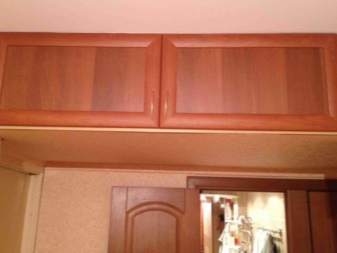
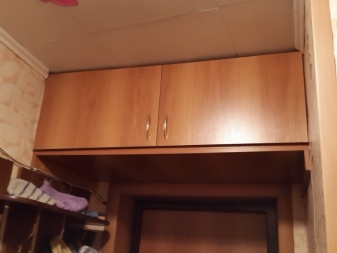
In a cramped hallway, you can store a lot of necessary things if you correctly design a mezzanine under the ceiling... And even a novice master will cope with this, because there are many design options, materials, accessories, and design scenarios, and all of them are relatively accessible even to a beginner.
Good luck!
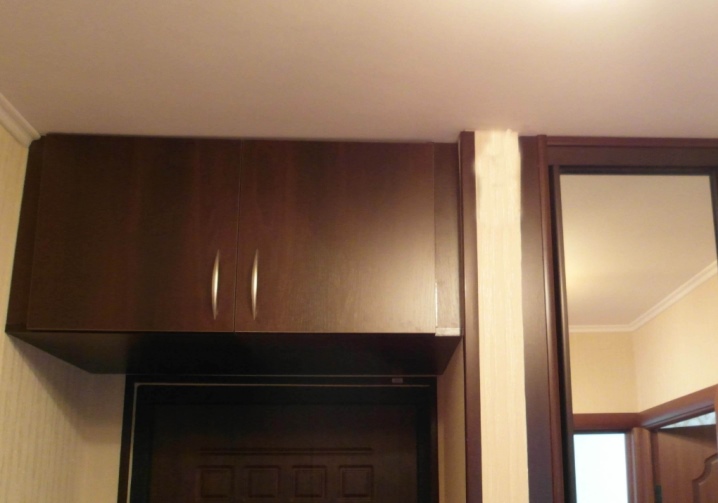
In the next video, you will learn how to make a mezzanine with your own hands.








The comment was sent successfully.